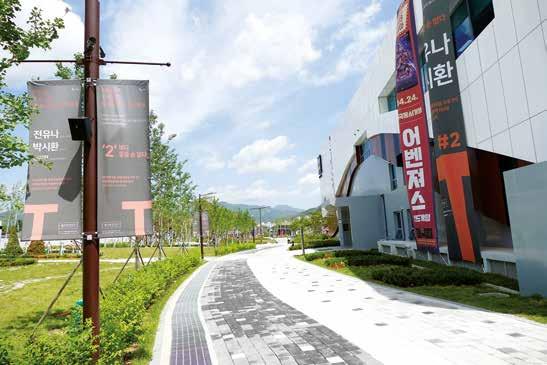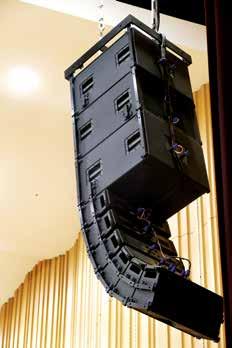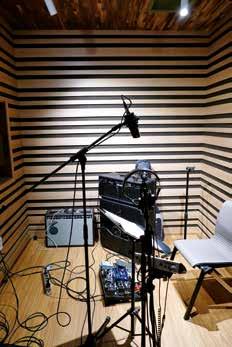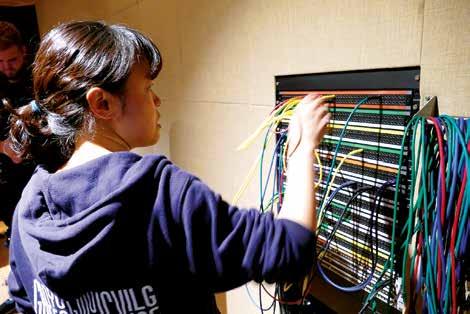
8 minute read
Rail track to Multitrack
A disused railway station has been transformed into a music performance and production centre by a South Korean artist. Richard Lawn reports from Music Village 1939

The Neve 88RS analogue console is at the heart of the studio
Advertisement
EIGHTY YEARS HAVE PASSED SINCE 66KM OF RAILWAY track connected the small town of Gapyeong to Seoul in the southwest of the country. When Gapyeong’s original train station was abandoned some years ago in favour of a high-speed connection, the city council was faced with a dilemma as to how best to transform the redundant site. Industrial facilities are discouraged in this idyllic hilly location, ensuring employment and revenue creation opportunities are somewhat limited in the town itself. Fortunately, a famous Korean producer and singer had a vision of transforming both the site and the fortunes of Gapyeong.
In the late 1970s, Hong-seop Song was working on the live circuit of predominantly US military bars and clubs on Incheon island as an aspiring bassist. Practising love and peace, Song recorded albums including Cho Yong Pil, Kim Hyun Sik, Han Young Ae, Spring Summer Autumn Winter, Love and Peace and Lee Eun Mi. Having performed at an annual music festival in Gapyeong, he saw the light and made it his mission to settle down there and create a music village.
Song’s vision to create a musical culture centre would take him the best part of 25 years to fulfil, and he became the chief architect in convincing the city council to invest in his dream. The repurposed and redesigned railway station combines historical and spatial symbolism.
Song explains.

Old rail tracks are now repurposed
From the outside, the semi-industrial, three-storey buildings provide no clues as to what goes on behind closed doors, even though some eagle-eyed locals may recognise artists such as soprano Sumi-Jo (Jo Su-gyeong) entering and leaving. Taking its name from the year of the railway station’s inception, Music Village 1939 incorporates indoor and outdoor theatres, a cinema, a recording studio, educational facilities and guest residences. Currently promoting around 25 music-related programmes a year, the music-themed complex represents the future of the Korean music industry.
Located adjacent to one another, M-Station is connected to S-Station along the old railway track by a wide, newly laid pavement – and a Dante network. M-Station combines a music hall and cinema together with offices, seminar rooms and a cafeteria.

Music Village CEO, Hong-seop Song
On entering the facility, the aroma of popcorn is evident, while the bright, light modern interior design betrays the façade of the exterior. The design of the artistic spaces within this unique facility is unmistakably that of Japanese acoustics innovator Masami ‘Sam’ Toyoshima. His transcendent acoustic design for some of the world’s iconic recording studios and contributions in the field of architectural acoustics earned him an AES Fellowship Award in 2011; one of many accolades that recognise his work.
The walls of the 12m x 16m music hall are treated with floor-to-ceiling wooden defractors and the 7.5m-high ceiling EQ and crossover networks, while RJ45 desktop control provides access to user EQ settings with the ability to store up to four user presets. Two 24,000W RMS amplification units within the 150kg cabinets drive the LF elements, while single 550W and 275W amplifiers serve the MF and HF units, respectively.
Integrated solutions specialist Music Metro was called upon to install the speaker elements into the control room.
explains Music Metro director, Brandon Han.

The main recording studio was designed by Sam Toyoshima
The bright, airy feel of the 7.5m-high studio that Toyoshima has created is an inspirational space. The three adjacent booths are connected to the main control room via combination panels incorporating sufficient microphone inputs in addition to ties, cues and controls. Currently, one booth is home to a Yamaha grand piano with twin DPA 4011 overhead mics, with percussionists and guitarists taking residence in the others.
While retaining a live ambience, the venue is naturally more suited to classical, jazz, theatrical and low-amplification performances.
For higher SPL requirements, engineers can remove the dust cover on the Soundcraft Vi2000 console and turn up the levels for the L-R JBL VerTec line array system. Powered by Crown amplifiers, each hang combines six VT4886 three-way modules with three VT4883 12-inch subwoofer elements arranged in cardioid mode, powered by Crown amplifiers. Loudspeaker management settings are stored in the preset controls of a BSS London BLU-806 processor. Performers can monitor themselves on JBL PRX415M wedges, but may prefer to use one of the eight IEM Sennheiser ew 300 G3 channels that transmit via two AC3 antenna combiners. A further eight channels of Sennheiser ew 500 microphone transmitters including handheld and lapel models are available, with eight receivers relying on two ASA-1 splitters.

JBL VerTec line array in the concert hall
While M-Station is essentially a venue for paying patrons, S-Station is a hideaway for recording artists. Here, systems integrator Audio Network Korea (ANK) worked closely with Toyoshima to faithfully reproduce his design blueprints. Complete with an editing room, the bright 309m 2 recording studio combines a live room with three separate booths and a control room.
Headed by former recording and mastering engineer Tom Kim, ANK also supplied the Neve 88RS analogue console that now assumes a commanding central location in the control room. Owing to its size, ANK was forced to dismantle and reinstall the 48-fader console in sections.
The informed choice to install an analogue console may be against the grain of the majority of today’s digital engineers, but Song feels it was justified. ‘Although there are operational advantages to a digital console, the Neve 88RS is a classic that does not date according to technical specification or trend. With its 100kHz bandwidth, it exceeds the 192kHz recording quality of the top digital boards. In addition to scoring, music recording and mixing, engineers can also perform surround format mixing on this console.’
Added mix colouration comes in the form of two Tube Tech CL1B compressors and an API Lunch Box that combines 10 API modules, including 512c mic preamps, 525 compressors, 550b EQs and 560 graphic EQs. Also taking pride of place among a focused inventory of outboard equipment is a Tektronix Leveling Amplifier Model LA-2A, which has merited its status as an iconic compressor/ limiter over the years. Using a Dante network, live performances can be recorded courtesy of the Cat-6 cabling infrastructure between the two Neve 1081R remote mic amp packs located at the FOH location in the music hall and the recording studio.

An AKG C414 mic in one of the booths
While the selection of a pair of ubiquitous Yamaha NS10a nearfield monitors is justified, the choice of mix monitoring in the control room was more of a personal attachment for Song, who chose a pair of PMC QB1-A large-scale studio monitors as the main reference speakers. A 5.1 surroundready setup has been created with the addition of five PMC twotwo.6 monitors and a twotwo sub2 subwoofer.
says Song.
Comprising four 10-inch carbon fibre/Nomex piston bass drivers, the QB1-A is capable of producing a maximum SPL of 132dB at 1m, without sacrificing accuracy or increasing distortion. Integrated DSP provides driver unit optimisation,

The drive units of the QB1-As had to be removed prior to installation
Upstairs, musicians can warm up in a large rehearsal room in full knowledge that their passionate and possibly off-key performances won’t be heard, courtesy of Toyoshima’s precision acoustics. Located on the same level, a postproduction suite furnished with an Avid console is further outfitted with a host of other editing tools. Racked
vertically on either wing of the console, the engineer can apply Maselec (MPL-2 HF limiter and MEA-2 stereo EQ), BAE (100CF compressor limiter and 1073MP dual-channel mic line) and SPL (Iron Mastering compressor, Passey passive EQ and DMC stereo mastering console) edits that are kept in sync courtesy of a Mutec MC-3+ USB smart
clock. Monitoring options include a pair of B&W Nautilus 800 D3 speakers powered by McIntosh MC611 Quad balanced power amplifiers or PMC result6 reference models. In his role as president and general director, Song doesn’t seem overawed by the responsibility that comes with his new title.
Looking at home in his M-Station upper-level office, he continues to write songs and mix them on his Apple Mac, using Sibelius Studio One 4, applying Universal Audio, Ableton Suite 10 and other plug-ins before sending his mix to the recording studio. Combining four inputs with a 16-channel summing mixer and a stereo bus compressor assignable to inputs or program bus, Song is enjoying recording and mixing on the API Box console that has been set up in his office by Music Metro.

Live patching
Having donated 37,257m 2 of decaying and disused railway infrastructure to Song, the town of Gapyeong is hoping that this investment will continue to cement its status as a centre of musical culture excellence. They are certainly on the right track.

